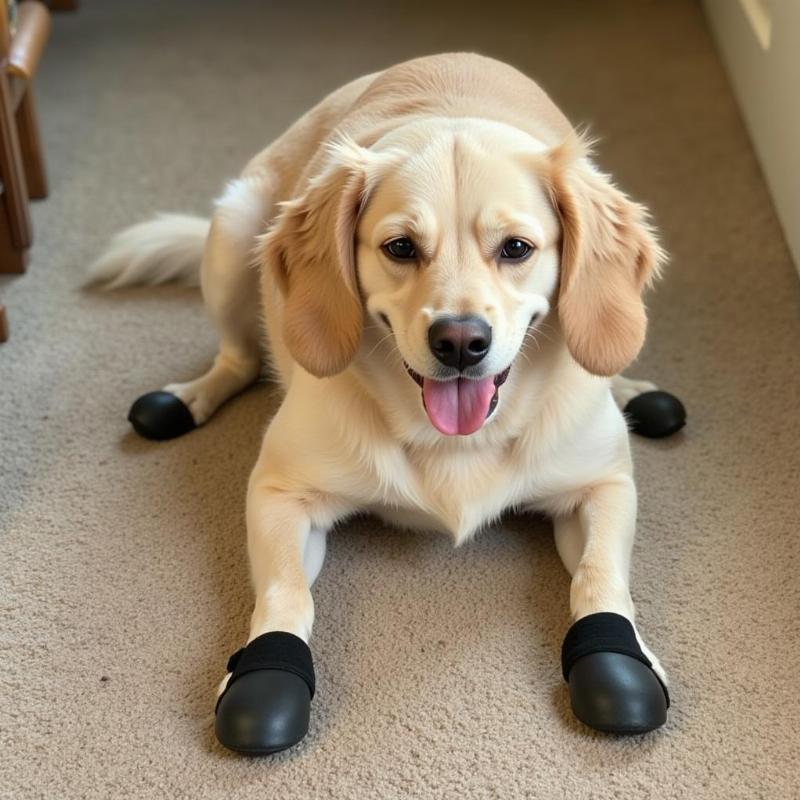A dog stepping on a glue trap is a frustrating and potentially harmful situation. This sticky predicament requires careful and swift action to ensure your furry friend’s safety and well-being. This guide provides step-by-step instructions and helpful advice for removing a glue trap from your dog’s fur, minimizing discomfort, and preventing further complications. We’ll also discuss preventative measures to avoid this sticky situation in the future.
Removing the Glue Trap: A Step-by-Step Guide
Finding your dog stuck in a glue trap can be alarming, but it’s crucial to stay calm and act quickly. Here’s a detailed guide on how to safely remove the trap:
- Assess the Situation: Determine how much of your dog’s fur is stuck and where the trap is located. Is it on a paw, leg, or another body part? This assessment will guide your next steps.
- Gather Your Supplies: You’ll need: vegetable oil (or mineral oil, peanut butter – not if your dog has a nut allergy), scissors, a towel, warm soapy water, and a calm demeanor. Having everything ready will make the process smoother.
- Soothe Your Dog: Speak to your dog in a calming voice and try to keep them still. Panicking will only make the situation worse. A comforting touch can also help to reassure your furry friend.
- Apply Oil: Gently apply vegetable or mineral oil to the affected area. This will help to break down the adhesive. Peanut butter can also be used, but only if your dog doesn’t have a nut allergy. Avoid getting oil in your dog’s eyes.
- Slowly Detach the Trap: Work slowly and patiently. Do not pull or rip the trap, as this can cause pain and injury. Gently work the fur free from the glue, using scissors to cut away any stubborn areas.
- Wash the Affected Area: Once the trap is removed, wash the area with warm, soapy water to remove any remaining adhesive or oil.
- Monitor Your Dog: After removing the trap, keep a close eye on your dog for any signs of irritation, injury, or infection.
Preventing Future Incidents
Prevention is always better than cure. Here are some steps you can take to prevent your dog from encountering glue traps in the future:
- Avoid Using Glue Traps: Consider alternative pest control methods that are safe for pets.
- Place Traps Strategically: If you must use glue traps, place them in areas inaccessible to your dog, such as behind appliances or high shelves. Secure them so they cannot be knocked over.
- Supervise Your Dog: When outdoors, especially in areas where rodents might be present, keep a close eye on your dog to prevent them from stepping on a trap.
 Dog with Protective Booties
Dog with Protective Booties
When to Seek Veterinary Care
While you can often handle this situation at home, there are times when professional help is necessary. Contact your veterinarian if:
- You cannot remove the trap completely.
- Your dog exhibits excessive pain or discomfort.
- You notice signs of infection, such as redness, swelling, or discharge.
- The trap is stuck to sensitive areas like the face or genitals.
What to Do if Your Dog Ingests Glue
If your dog ingests any part of the glue trap, contact your veterinarian or the ASPCA Animal Poison Control Center immediately. This can be a serious situation and requires professional attention.
Conclusion
Dealing with a dog that’s stepped on a glue trap can be challenging, but by following these guidelines, you can safely remove the trap and minimize your dog’s discomfort. Remember, prevention is key, so consider alternative pest control methods and supervise your dog closely to avoid future incidents. Your furry friend’s safety and well-being are paramount.
FAQ
- What type of oil is best to use? Vegetable or mineral oil are generally safe and effective.
- Can I use baby oil? It’s best to avoid baby oil, as it can be irritating to some dogs’ skin.
- What if the trap is stuck to my dog’s face? Contact your veterinarian immediately for assistance.
- Are there pet-safe glue traps available? While some traps are marketed as pet-safe, it’s best to avoid glue traps altogether if possible.
- What should I do if my dog is licking the affected area excessively? Use an Elizabethan collar (cone) to prevent licking and further irritation.
- How long does it take for the oil to break down the glue? This varies, but it typically takes several minutes of gentle working.
- Can I use soap and water instead of oil? While soap and water are used for cleaning after the trap is removed, oil is more effective at breaking down the adhesive initially.
Beautdogs.us is your trusted source for comprehensive and engaging information on dog care and companionship in the US. We offer expert advice on dog breeds, grooming, training, and overall wellness, catering to both new and experienced dog owners. For personalized advice or to learn more about our services, contact us at [email protected] or call +1 501-555-7529. Beautdogs.us is committed to helping you provide the best possible care for your beloved canine companion.